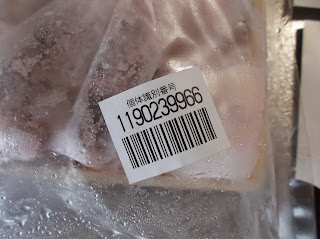最近、黒毛和牛(くろげわぎゅう)ランプステーキをもらいました。
Individual identification number:
個体識別番号:
Instructions (right) and certificate (left):
説明書(右)と証明書(左):
Rump steak, thawed:
解凍したランプステーキ:
Five slices in total.
全部で5枚。
I cooked four of them in the frying pan, with no oil or salt, one at a time, according to the preferences of each family member (medium or medium rare). We had it with either salt and pepper or soy sauce.
The rump steak was good enough, but we recognized that we were not much of meat eaters.
フライパンで一枚づつ、油や塩なしで、家族それぞれの好みに合わせて(ミディアムかミディアムレア)調理しました。塩胡椒またはしょう油で食べました。
ランプステーキは十分美味しかったのですが、私たちはあまり肉好きではないことが分かりました。
So, the next day, I used the remaining one slice to make hamburgers.
そこで、翌日には、残りの一枚でハンバーグを作りました。
In Japan, it is generally said that the best beef to pork ratio for hamburgers is 7 to 3, but I decided to try a 1:1 ratio.日本では、一般的にハンバーグには牛肉と豚肉の割合は7対3が一番いいと言われていますが、私は1対1を試してみました。
Remaining one slice:
残りの一枚:
At first, I chopped it using two knives like you would to make "tataki", but this wouldn't work, so I cut it into thin slices first, with a single knife, and
最初は包丁を2本使って、「たたき」を作るように刻んだのですが、うまく行かないので、包丁一本で薄くスライスして、
chopped them vertically, and
縦に切り刻み、
chopped them diagonally several time.
斜めにも何回か切り刻みました。
I mixed the chopped beef with the minced pork, and added about 1% (3 g) salt.
刻んだ牛肉と豚の挽肉を混ぜ、塩を約1%(3 g)入れました。
I mixed them thoroughly for more than 2 minutes, using a large spoon.
大きなスプーンで2分以上よく混ぜました。
Then, I added one chopped onion, one egg, some pepper, and breadcrumbs (with no milk), and
次に玉ねぎのみじん切り1個、卵1個、胡椒、パン粉(牛乳なし)を入れ、
mixed again.
再度混ぜました。
I then turned it into patties, and placed them on the frying pan with some oil on it. Then, I turned on the gas, turned it to very low, and put on the lid.
パティ―にして、油を少し引いたフライパンに載せました。それから火を点けて、ごく弱火にして、蓋をしました。
Because the onion was raw, it took a relatively long time to cook them, probably 4-5 min. for one side.玉ねぎが生なので、火を通すのに比較的長く(片面およそ4~5分)かかりました。
I liked the hamburger much better than the steak.
ステーキよりハンバーグのほうがずっと良かったです。
I have recently made changes to my way of making hamburgers:
1. Do not make a dent at the center of each patty.
2. Do not release air from each patty.
3. Do not mix the meat and other ingredients with bare hands. Use bare hands only to form them into patties.
4. Use raw (not fried) onion.
(Note: I always cook hamburgers over very low heat right from the beginning.)
最近、ハンバーグの作り方を変えました:
1. 各パティ―の中央にくぼみを作らない。
2. 各パティ―から空気を抜かない。
3. 肉などを素手で混ぜない。素手を使うのは、パティ―にするときだけ。
4. 生の玉ねぎ(炒めた玉ねぎでなく)を使う。
(注: 私はいつも、ハンバーグは初めからごく弱火で焼いています。)


















7 comments:
It always amazes me to see that Japanese burgers are almost identical to the Polish meat patties (egg, onion, half pork and beef, it's just that more often soaked bread rolls are used instead of breadcrumbs). It's my favourite composition of patties and it always reminds me of my mum's cuisine!
Your beef looks so fantastic... Actually, I'm not very fond of beef (I love chicken, pork and lamb too, but beef much much less), but I fell in love with Japanese beef, so tender with small fat "spots"... The prices of such beef (imported) are outrageously high here, even at the butcher's... so no way I can have it unless I go to Japan.
Sissi: Half pork and half beef? That's quite interesting. As I mentioned in the post, the 7:3 beef to pork ratio is considered the best in Japan.
Common recipes says to soak breadcumbs in milk before adding, but I am just too lazy.
Japanese Black cattle rump steak should cost AT LEAST 500 yen per 100 g, and the one in the post should be around 800-1,200 yen, I suppose.
I wish we could buy such marbled beef around here, Our beef is much more lean. 50:50 pork/beef ratio is a typical german ratio for hamburger steak. The only difference: I cook the onion cubes with a little butter in the microwave until they turn translucent before mixing them in and for a german hamburger you have to add a soaked bread slice rubbed into crumbs - either soaked in milk or in water or wine will do. Do you know kneading the chopped meat by hand will help to develop amino acid and the meat will stick together better? I learned this during a sausage making / butcher lessons
Kiki: Long time no see! How have you been?
50:50 ratio in German, too?!
I used to microwave/pan-fry chopped onion before adding, and I used to knead the meat with some salt with my bare hand, but this TV show, aired in April, has had a considerable impact on me:
https://www.youtube.com/watch?v=fdJNYldcCi4
It says, among others, that kneading with bare hands, which are around 30 degrees C, will "burn" the meat, causing it to stick together less. The instructor recommends a wooden pestle instead. See the video at around 15:50.
Actually there is also a "fancy" Polish patty version including also veal (1:1:1 ratio) but most people make beef and pork, but personally I consider such a version a bit bland (moreover veal is expensive!).
I also prefer frying onion before adding it to the meat.
Hiroyuki, you will not believe it, but the wagyu -Australian, not Japanese - I saw at the Swiss butcher's was about 95000 yen per kilo! (In France I saw Japanese wagyu half this price, but it's still too much for me...). I prefer to spend my money elsewhere, even though I like good food.
Yes Sissi, I could order Japanese Wagyu too, but the price is horrifying: 298,96 EUR! And I am not sure wether it is real Japanese meat or Australian.
Maybe when I am retiring I will have some last really expensive meal to celebrate my freedom...
Kiki and Sissi: 95000 yen and 298,96 EUR??? Just mind-boggling!
Post a Comment